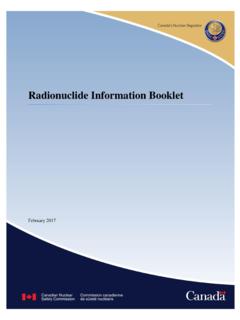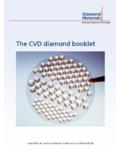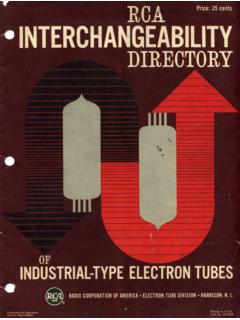Transcription of X-Ray Data Booklet Section 5.4 RADIOACTIVITY …
1 X-Ray data Booklet Section RADIOACTIVITY AND radiation protection The International Commission on radiation Units and Measurements (ICRU) recommends the use of SI units. Therefore, we list SI units first, followed by cgs (or other common) units in parentheses, where they differ. A. DEFINITIONS Unit of activity = becquerel (curie): 1 Bq = 1 disintegration s 1 [= 1/( 1010) Ci] Unit of absorbed dose = gray (rad): 1 Gy = 1 J kg 1 (= 104 erg g 1 = 100 rad) = 1012 MeV kg 1 deposited energy Unit of exposure, the quantity of x- or - radiation at a point in space integrated over time, in terms of charge of either sign produced by showering electrons in a small volume of air about the point: = 1 C kg 1 of air (roentgen; 1 R = 10 4 C kg 1) = 1 esu cm 3 (= erg released energy per g of air) Implicit in the definition is the assumption that the small test volume is embedded in a sufficiently large uniformly irradiated volume that the number of secondary electrons entering the volume equals the number leaving.
2 Unit of equivalent dose for biological damage = sievert. 1 Sv = 100 rem (roentgen equivalent for man). The equivalent dose in Sv = absorbed dose in grays wR, where wR is the radiation weighting factor (formerly the quality factor Q), which depends upon the type of radiation and other factors, as shown in Table 5-3. The equivalent dose expresses the long-term risk (primarily due to cancer and leukemia) from low-level chronic exposure. B. radiation LEVELS Natural annual background from all sources. In most of the world, the whole-body equivalent dose rate 4 mSv (40 400 mrem). It can range up to 50 mSv (5 rem) in certain areas. The average mSv, including about 2 mSv ( 200 mrem) from inhaled natural RADIOACTIVITY , mostly radon and radon daughters. This radon exposure value is for a typical house; radon exposure varies by more than an order of magnitude. Cosmic ray background in counters (Earth s surface): ~1 min 1cm 2 sr 1. Man-made radiation dose: The greatest contribution to man-made radiation dose has been from irradiation from X-Ray diagnostics in medicine, which accounts for about 20% of the average natural radiation dose.
3 Table 5-3. radiation weighting factors. Type of radiation wR X- and -rays, all energies 1 Electrons and muons, all energies 1 Neutrons: < 10 keV 5 10 100 keV 10 2 MeV 20 2 20 MeV 10 > 20 MeV 5 Protons (other than recoils), > 2 MeV 5 Alphas, fission fragments, and heavy nuclei 20 Fluxes (per cm2) to deposit one Gy, assuming uniform irradiation: For photons: 109 /Ef, for photons of energy E [MeV], attenuation length (g cm 2), and fraction f 1 expressing the fraction of the photon s energy deposited in a small volume of thickness << but large enough to contain the secondary electrons. 2 1011 photons cm 2 for 1-MeV photons on carbon (f ). For charged particles: 109/(dE/dx), where dE/dx [MeV g 1 cm2), the energy loss per unit length, may be obtained from range-energy figures. 109 cm 2 for minimum-ionizing singly-charged particles in carbon. Quoted fluxes are good to about a factor of two for all materials.]
4 Recommended exposure limits for radiation workers (whole-body dose): ICRP: 20 mSv yr 1 averaged over 5 years, with the dose in any one year 50 mSv. : 50 mSv yr 1 (5 rem yr 1). Many laboratories in the and and elsewhere set lower limits. Lethal dose: Whole-body dose from penetrating ionizing radiation resulting in 50% mortality in 30 days (assuming no medical treatment), about 5 Gy (500 rads) as measured internally on body longitudinal center line. Surface dose varies owing to variable body attenuation and may be a strong function of energy. This Section was adapted, with permission, from the 1999 web edition of the Review of Particle Physics ( ). For further information, see ICRP Publication 60, 1990 Recommendation of the International Commission on Radiological protection (Pergamon Press, New York, 1991) and E. Pochin, Nuclear radiation : Risks and Benefits (Clarendon Press, Oxford,1983).










